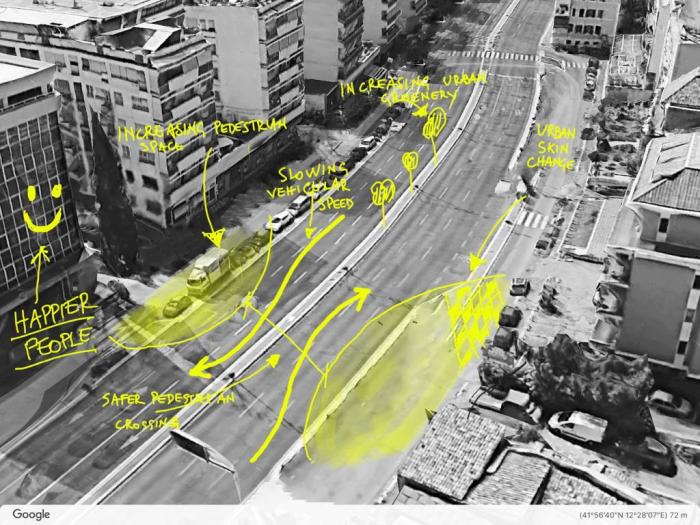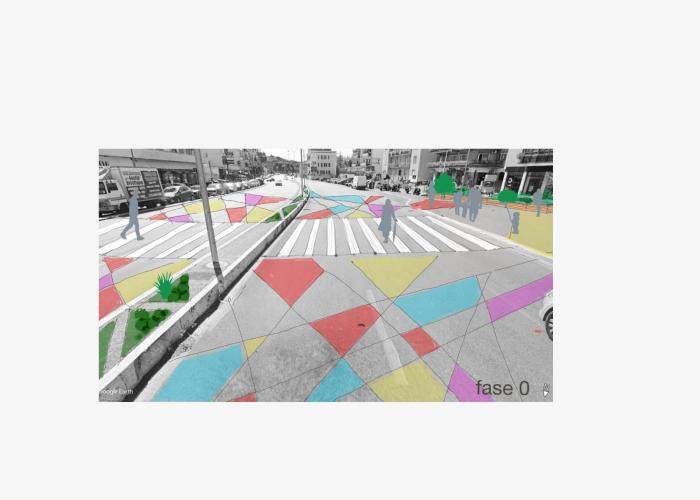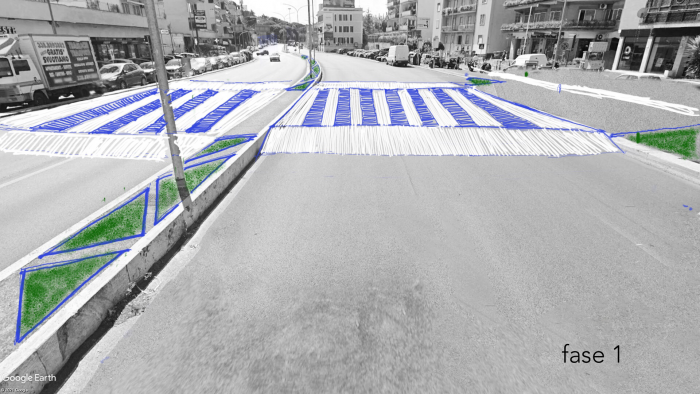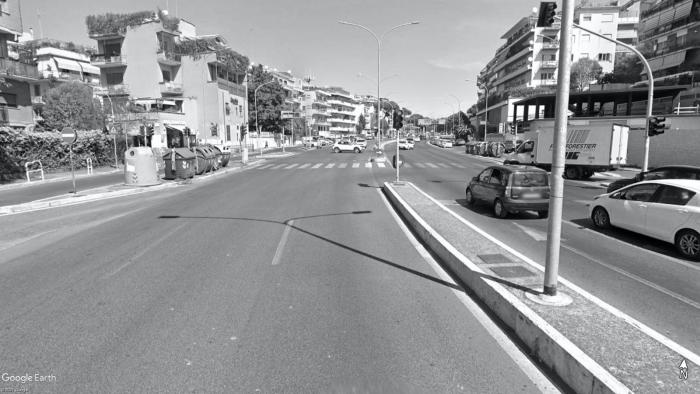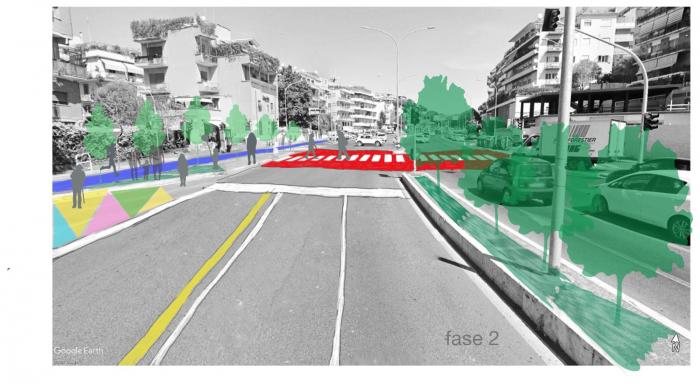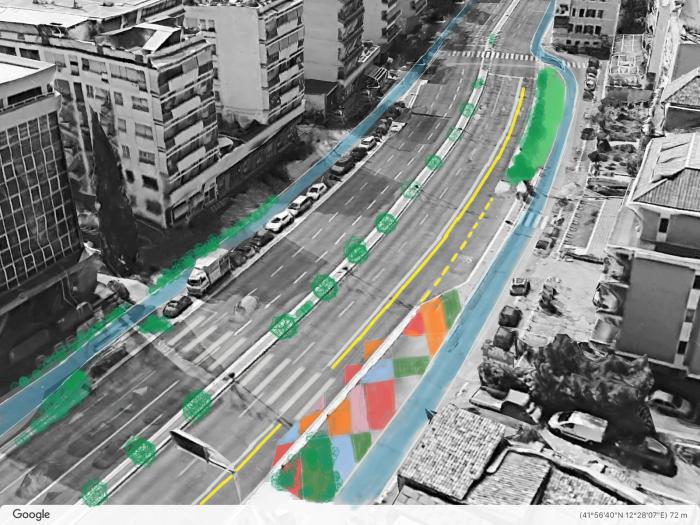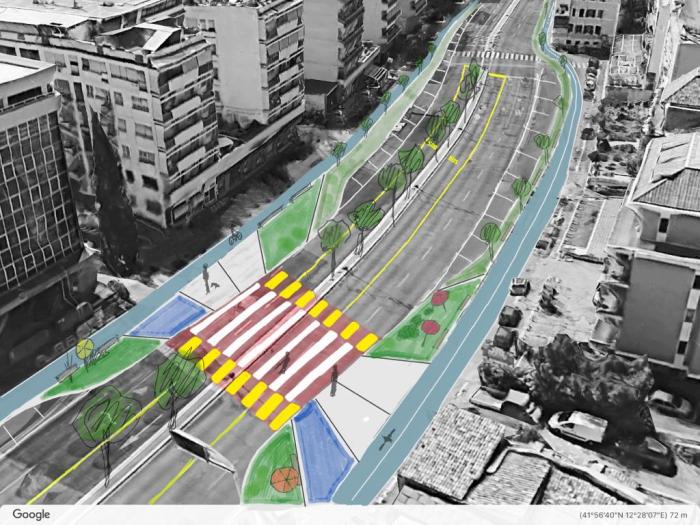I. SUMMARY INFORMATION
Project
268906
Status
Submitted
Award category
Techniques, materials and processes for construction and design
You want to submit
NEW EUROPEAN BAUHAUS RISING STARS : concepts or ideas submitted by young talents (aged 30 or less)
Project title
Rethinking Corso Francia
Full concept/idea title
A road map for co-design aiming at road safety, sustainable mobility and quality of public space
Description
Corso Francia is a dangerous, grey, non-sustainable and non-inclusive urban highway. We want to transform it into a tree-lined sustainable boulevard, rich in social opportunities and beauty.
As a collective of young citizens we want to take on this challenge through a participatory process. We will hear from street users and stakeholders, using both in person co-design meetings and a plan-it-yourself website, open to all citizens who aim to submit their proposals for the use of public space.
Where is your concept/idea being developed or intended to be implemented in the EU?
Italy
Lazio
Corso di Francia
Rome
00191
II. DESCRIPTION OF THE PROJECT
Please provide a summary of your concept/ idea
Rethinking Corso Francia is a project which aims to reshape an important urban street in Rome in terms of increasing road safety, promoting sustainable mobility and improving the quality of public spaces.
Corso Francia is a highly trafficked street located in the northern area of the capital. Having been conceived at a time of great expansion of private motorised traffic, this key artery is now a six-lanes urban motorway in the centre of a densely populated area of Rome.
The current layout of Corso Francia creates a profound barrier within an urban texture that is purely commercial and residential; it puts the users in different modes of mobility at great risk, and represents the perpetration of a model of private use of public space that generates environmental pollution and mortifies beauty.
The project consists of both an indicative proposal, accompanied by graphic designs, and a participatory process inspired by the criteria of co-design and co-production of common goods. The promoting association has already undertaken a process of awareness-raising , involved citizens and developed the indicative proposal having also the opportunity to discuss it with the public administration. The project aims to launch a series of co-design stages with inhabitants and stakeholders, starting in September 2021.
Particularly, after an initial phase of analysis of existing criticalities and stakeholder mapping, there will be a listening and subsequent co-design phase with all the individuals and bodies involved in the project. At the end of this process, 3 or 4 different projects will be presented, each one shaped by the views and ideas of a particular group (e.g. "elderly people" or "students"). The projects will be subject to a public vote and then submitted to the competent decision-maker.
Please give information about the key objectives of your concept/idea in terms of sustainability and how these would be met
Rethinking Corso Francia meets the principle of sustainability in its three dimensions: environmental, economic and social. This is in line with the Sustainable Development Goals of the United Nations 2030 Agenda.
Environmental sustainability is directly pursued by two of the three main objectives of the project, namely promoting sustainable mobility and improving the quality of public spaces. The first one pursues it through an increase of low or zero emission forms of mobility, achieved by their facilitation. The second one promotes it through the improvement of the environmental conditions of the street: the decrease of low reflectance surfaces (which favour urban heat islands), and of high impermeability surfaces (which disrupt the water cycle), the increase of vegetation mass (able to absorb polluting emissions) and the promotion of a healthier lifestyle for people's lives and the urban ecosystem.
Economic sustainability is fostered through the development of an incremental methodology, which does not seek to impose to the community a preconceived project from above with a high risk of failure and to the serious detriment of the public purse. On the contrary, the process of analysis, listening, co-production and co-design will make it possible to set up a milieu for proposals, experimentation and shared evaluation, designed to minimise the waste of resources and not gradually accustom people to change but also create support for such a change.
Social sustainability is pursued on the one hand by the reduction of serious traffic fatalities, as increasing road safety is one of the three main objectives of the project, and on the other by a participatory methodology, aimed at taking different points of view and particularly those of the most socially fragile and normally unheard people. This also reflects the desire not to exacerbate tensions within an already highly polarised society, but to focus on exchange as a means of achieving collective well-being.
Please give information about the key objectives of your concept/idea in terms of aesthetics and quality of experience beyond functionality and how these would be met
Our project puts in place strategies that allow the public space, rebalanced in the amount of surface area allocated to the functions that are to be performed, to become a place of possible coexistence between pedestrians, cyclists and cars and give the possibility to enjoy a more beautiful urban landscape
The public space represented by Corso Francia continues to be an inhospitable expanse of asphalt with several lanes for almost exclusive use of cars, offering a divided, dangerous, unbalanced and degraded space.
In the spaces remodeled in favor of pedestrians, all the "actors" of the urban space can "naturally" find their place; allowing pedestrians to occupy larger, more comfortable, safer and more beautiful spaces, increasing urban greenery by moving from the concept of ornamental vegetation to that of functional vegetation, are actions that promote greater accessibility to all users of public space.
The new design of a wider network of bicycle paths and a more extensive network of pedestrian surfaces, both with additional vegetation, will have positive effects on increasing the availability of meeting places and collective facilities, transforming Corso Francia into a place where even those who have difficulty using private motorized vehicles do not feel excluded from access to important assets.
Second, what can be further gained from the redefinition of urban space is the regeneration of asphalt surfaces that will need to be rethought and replaced by adopting more appropriate and beautiful materials.
The new "skin" of the urban space will return to us more accessible, less polluted, more beautiful public spaces.
Giving back permeable spaces, taking away parts of the asphalt to add vegetal elements, not only meets an aesthetic need but helps the urban environment to adapt to new conditions imposed by changing weather patterns and improve bio-climatic comfort and health conditions giving us more a welcoming, livable and beautiful street.
Please give information about the key objectives of your concept/idea in terms of inclusion and how these would be been met
Inclusion is a key of Rethinking Corso Francia, starting with our motivation: currently Corso Francia is a high-speed, eight-lane urban street with close to no sidewalk, scarcely accessible for children, elderly people, and citizens with reduced mobility, where spatial justice is not even conceivable. In this regard, those groups will be among the most involved during our participatory co-design process, tuning our meetings and communication to the needs and the preferences of the various groups.
The process will allow participation both online, through a “plan-it-yourself” app and website, and offline, via several in-person meetings.
The app will allow users to design an allocation of public space for the section of the road targeted, selecting urban design features, previously agreed with the citizens (such as bike lanes, trees, sidewalks, benches, impaired vision aids, etc.), via a drag and drop system. It will be made available both on mobile devices and on the project’s website. Users will be able to submit their design, which will be added to a public database. The user will be provided with a “mobility score” for each of the possible categories, spanning from pedestrians and citizens with a reduced mobility to cyclists, public transport users and motorized vehicles’ drivers.
On the other hand, the participatory process will entail in-person co-design meetings organized in nearby community facilities, including schools, public facilities and churches, with approaches and presentations adapted to enhance the participation of citizens of all ages and backgrounds. At least one meeting will be specifically targeted to persons with impaired mobility and/or vision, at least one for cyclists, at least one for public transport users and at least one for elderly citizens. Finally, at least one meeting will be held in a facility easily accessible to minority citizens residing in the area, with presentations available in at least two languages besides Italian.
Please explain the innovative character of your concept/ idea
Corso Francia, the street at the centre of the project, was built in its current appearance at the time of the unbridled building development of the city of Rome in the 1960s and 1970s. The fact that Corso Francia and the surrounding neighbourhoods, as well as most of the city, developed in those years meant that the infrastructure and shape of the streets still reflects a centrality of the car that is still strongly rooted in the culture of the inhabitants.
Rethinking Corso Francia means reversing this cultural taboo by redistributing among different uses of the street surfaces, which today are almost exclusively devoted to transit of cars and motorbikes, with regards to road safety, sustainable mobility and quality of public space. Such a project for a "democratisation" of public space and the systematic protection of weaker road users is in itself a profoundly innovative instance in a context that has remained unchanged for years, such as that of Corso Francia, towards a more sustainable, inclusive and happy future.
In a city such as Rome, where projects are normally imposed from above, but where civic involvement is growing, Rethinking Corso Francia aims to build a project shared by all: citizens, associations, institutions and local authorities. The paradigm shift is that only a project that is not based on contrast, but on inclusion and involvement, can enjoy the necessary support from citizens and thus be truly effective in the pursuit of its objectives.
The desire to bring about a change in the way citizens relate to the city is clearly manifested within the participatory process, with the collective design of 3 or 4 different scenarios for Corso Francia that take on as many different but intersecting instances (e.g. "elderly person" or "student"), on which to catalyse the consensus of the citizens.
Please detail the plans you have for the further development, promotion and/or implementation of your concept/idea, with a particular attention to the initiatives to be taken before May 2022
Rethinking Corso Francia will be presented to the local council of the Fifteenth Municipality of Rome, with a motion involving at least two political forces from different parties. This will have the aim of formally committing the local administration to support the project throughout its journey (Jun-Aug 2021).
In September, the analysis phase will begin, involving the project team in the presentation of the objectively verifiable criticalities concerning the road and its surroundings, and in the mapping of potential stakeholders. At the same time, an information campaign will be addressed to all citizens, with the aim of involving as many individuals and associations as possible in the collective planning process (Sep-Oct 2021).
The second phase will involve listening to citizens and stakeholders on what they consider to be critical about Corso Francia. At the same time, needs and desires regarding the future of the street will be collected during a first large public assembly. Thereafter, meetings will be held on a regular basis. A first test will be the co-production of a small portion of public space of Corso Francia, to show that changing the road together for the better is possible (Nov-Dec 2021).
Afterwards, the third and last phase will begin, involving co-designing, together with citizens and stakeholders, the broader section of the street. The work will be carried out with the help of an online platform that will allow everyone to express their ideas. The outcome of this phase will be the presentation of 3 or 4 different projects, each one reflecting the point of view of a particular group, for example "elderly people" or "students" (Jan-Mar 2022).
After a public presentation, the projects will be submitted to a public vote, which will elect a winner. In the end, the final decision will be taken by the competent authority, which will have participated in the previous phases (Apr-May 2022).
III. UPLOAD PICTURES
IV. VALIDATION
By ticking this box, you declare that all the information provided in this form is factually correct, that the proposed concept/idea has not been proposed for the New European Bauhaus Rising Stars Awards more than once in the same category.
Yes
